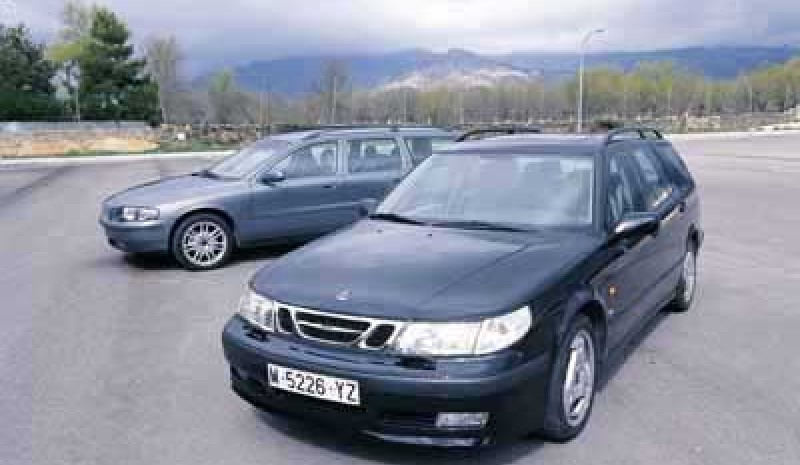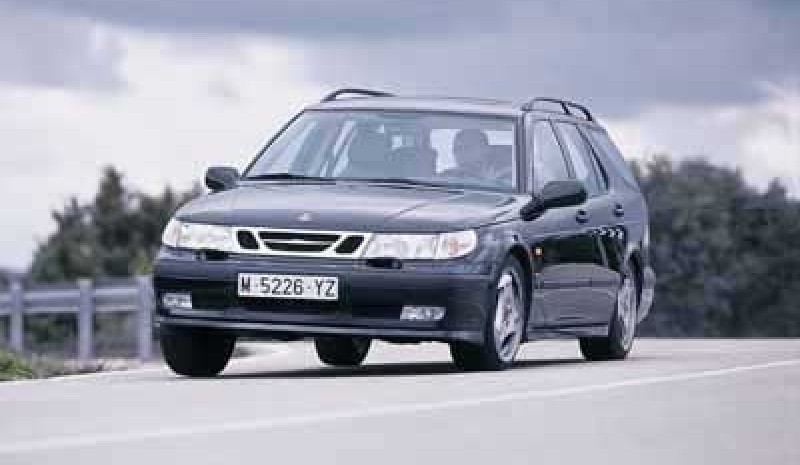Saab 9-5 Aero 2.3 SW / Volvo V70 T5 Optimal
Besides offering comfort, good habitability and reasonable capacity, the two opposing models allow Swedish extraordinary, worthy of high level sports performance models.


It is difficult to prioritize which clearly defines the most important features of these two models. You can be familiar a sports car? You can be sporty family car? The truth is that the answers are affirmative in both cases, which represents an important for those who need a large and capable vehicle without giving up a first class performance advantage. In addition, any of them can become an excuse for acquisition, putting the advantages of a family vehicle to the exuberant power figures that develop their turbocharged engines, as only the most skilled in the art will recognize that it is variants more powerful and sporting offering both brands. There are too many aesthetic additions to unveil the relevant dynamic characteristics that are capable of achieving.
The Aero striking by its original alloy wheels 17 inches and three spokes, the flared wheel, the recessed body, the presence of a front spoiler or oval chrome exhaust outlet. The Volvo is quite unobtrusive and might go unnoticed but for the anagram that identifies the version as attractive alloy wheels mounted unit tests -of same diameter as the Saab- are optional (70,049 pesetas. ) the line of this is much more modern and updated style complements the family of the brand with the dynamic qualities of the S80, which takes its base.
Although aesthetically not have anything to do, the two seem to be designed under the same specifications, as almost all interior dimensions are similar, if not identical. Space for occupants satisfactory in all places, although more available height seen in the rear seat of Saab. Porters also offer a load capacity very similar, but none of them stands out for extraordinary figures. While the Volvo-a slightly older dominates the width of the trunk, the Saab offers more depth and greater height. In this regard it should be noted the usefulness of the rear tray Saab, rigid, collapsible and easy to handle, which can be adjusted according to the needs of the load.
The inside is completely different, but both models quality, design and elegance shown. The Saab 9-5 maintains the usual characteristic style in brand models, with details known since the late 9000. And is that some of its solutions remain valid and interesting, as the practical outputs of air conditioning -orientables by superpuestas- celled double umbrellas, the key switch located between the front seats or the buttons of the window. One consequence of a design that comes from afar and no longer admissible in a model of this category is that it has no steering wheel adjustment height, which coupled with the low fastening seat does not contribute to favor the position of driving; also it has no gaps or specific departments to leave things with you on. The opposite is true in the Volvo, which boasts a more discreet and conventional interior, but more functional. They pick your seats well the body curves and offer superb comfort. The controls are arranged more conventional way and is easy to operate.
Comfort is a notable feature in both, encouraged by the smooth running of the engine smooth running, the space available inside the low noise seeping into the cabin, excellent climate and extensive equipment that have series. The suspensions also help promote the smooth entire atmosphere inside; although they are quite strong, they do not reach too uncomfortable for passengers. In the Saab lower hardness buffer permitting some body roll in virados sections and determines excessive traction control operation shown. Curve and to an overemphasis of the accelerator pedal, the engine power is just so suddenly reaches the tire inner wheel of the curve is not able to provide enough grip. That is when traction control handles reduce torque to restore the situation. The operation of this device, which can be unwound is little intrusive for the driver because it acts very smoothly and without abrupt reactions.
In the Volvo, more powerful on paper, firmer suspension provide good poise and allow more effective behavior. Abuse throttle curve also brings about the performance of traction control system, which in this case is accompanied by an effective stability control system that manages serial neutralize most of the abuses committed by the driver. However, with disconnected systems control both show their dominance of weight in the front, with a clear intention of leaving nose in tight corners. Under these conditions force hold the steering wheel firmly, because the direction pulls very strongly. Motorways, main circulating more pleasant Aero direction, as in the T5 is too sensitive to movement and requires more attention. When parking or not help maneuver the wheels of 17 inch optional T5, which greatly increase the radius of gyration too.
It is difficult to prioritize which clearly defines the most important features of these two models. You can be familiar a sports car? You can be sporty family car? The truth is that the answers are affirmative in both cases, which represents an important for those who need a large and capable vehicle without giving up a first class performance advantage. In addition, any of them can become an excuse for acquisition, putting the advantages of a family vehicle to the exuberant power figures that develop their turbocharged engines, as only the most skilled in the art will recognize that it is variants more powerful and sporting offering both brands. There are too many aesthetic additions to unveil the relevant dynamic characteristics that are capable of achieving.
The Aero striking by its original alloy wheels 17 inches and three spokes, the flared wheel, the recessed body, the presence of a front spoiler or oval chrome exhaust outlet. The Volvo is quite unobtrusive and might go unnoticed but for the anagram that identifies the version as attractive alloy wheels mounted unit tests -of same diameter as the Saab- are optional (70,049 pesetas. ) the line of this is much more modern and updated style complements the family of the brand with the dynamic qualities of the S80, which takes its base.
Although aesthetically not have anything to do, the two seem to be designed under the same specifications, as almost all interior dimensions are similar, if not identical. Space for occupants satisfactory in all places, although more available height seen in the rear seat of Saab. Porters also offer a load capacity very similar, but none of them stands out for extraordinary figures. While the Volvo-a slightly older dominates the width of the trunk, the Saab offers more depth and greater height. In this regard it should be noted the usefulness of the rear tray Saab, rigid, collapsible and easy to handle, which can be adjusted according to the needs of the load.
The inside is completely different, but both models quality, design and elegance shown. The Saab 9-5 maintains the usual characteristic style in brand models, with details known since the late 9000. And is that some of its solutions remain valid and interesting, as the practical outputs of air conditioning -orientables by superpuestas- celled double umbrellas, the key switch located between the front seats or the buttons of the window. One consequence of a design that comes from afar and no longer admissible in a model of this category is that it has no steering wheel adjustment height, which coupled with the low fastening seat does not contribute to favor the position of driving; also it has no gaps or specific departments to leave things with you on. The opposite is true in the Volvo, which boasts a more discreet and conventional interior, but more functional. They pick your seats well the body curves and offer superb comfort. The controls are arranged more conventional way and is easy to operate.
Comfort is a notable feature in both, encouraged by the smooth running of the engine smooth running, the space available inside the low noise seeping into the cabin, excellent climate and extensive equipment that have series. The suspensions also help promote the smooth entire atmosphere inside; although they are quite strong, they do not reach too uncomfortable for passengers. In the Saab lower hardness buffer permitting some body roll in virados sections and determines excessive traction control operation shown. Curve and to an overemphasis of the accelerator pedal, the engine power is just so suddenly reaches the tire inner wheel of the curve is not able to provide enough grip. That is when traction control handles reduce torque to restore the situation. The operation of this device, which can be unwound is little intrusive for the driver because it acts very smoothly and without abrupt reactions.
In the Volvo, more powerful on paper, firmer suspension provide good poise and allow more effective behavior. Abuse throttle curve also brings about the performance of traction control system, which in this case is accompanied by an effective stability control system that manages serial neutralize most of the abuses committed by the driver. However, with disconnected systems control both show their dominance of weight in the front, with a clear intention of leaving nose in tight corners. Under these conditions force hold the steering wheel firmly, because the direction pulls very strongly. Motorways, main circulating more pleasant Aero direction, as in the T5 is too sensitive to movement and requires more attention. When parking or not help maneuver the wheels of 17 inch optional T5, which greatly increase the radius of gyration too.


